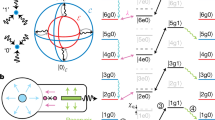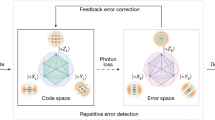Abstract
Universal quantum computation1 is striking for its unprecedented capability in processing information, but its scalability is challenging in practice because of the inevitable environment noise. Although quantum error correction (QEC) techniques2,3,4,5,6,7,8 have been developed to protect stored quantum information from leading orders of error, the noise-resilient processing of the QEC-protected quantum information is highly demanded but remains elusive9. Here, we demonstrate phase gate operations on a logical qubit encoded in a bosonic oscillator in an error-transparent (ET) manner. Inspired by refs. 10,11, the ET gates are extended to the bosonic code and are able to tolerate errors on the logical qubit during gate operations, regardless of the random occurrence time of the error. With precisely designed gate Hamiltonians through photon-number-resolved a.c. Stark shifts, the ET condition is fulfilled experimentally. We verify that the ET gates outperform the non-ET gates with a substantial improvement of gate fidelity after an occurrence of the single-photon-loss error. Our ET gates in superconducting quantum circuits can be readily extended to multiple encoded qubits and a universal gate set is within reach, holding the potential for reliable quantum information processing.
This is a preview of subscription content, access via your institution
Access options
Access Nature and 54 other Nature Portfolio journals
Get Nature+, our best-value online-access subscription
$29.99 / 30 days
cancel any time
Subscribe to this journal
Receive 12 print issues and online access
$209.00 per year
only $17.42 per issue
Buy this article
- Purchase on Springer Link
- Instant access to full article PDF
Prices may be subject to local taxes which are calculated during checkout




Similar content being viewed by others
Code availability
The code used for simulations is available from the corresponding authors upon reasonable request.
References
Nielsen, M. A. & Chuang, I. L. Quantum Computation and Quantum Information (Cambridge Univ. Press, 2000)
Chiaverini, J. et al. Realization of quantum error correction. Nature 432, 602–605 (2004).
Schindler, P. et al. Experimental repetitive quantum error correction. Science 332, 1059–1061 (2011).
Reed, M. D. et al. Realization of three-qubit quantum error correction with superconducting circuits. Nature 482, 382–385 (2012).
Yao, X.-C. et al. Experimental demonstration of topological error correction. Nature 482, 489–494 (2012).
Waldherr, G. et al. Quantum error correction in a solid-state hybrid spin register. Nature 506, 204–207 (2014).
Nigg, D. et al. Quantum computations on a topologically encoded qubit. Science 345, 302–305 (2014).
Kelly, J. et al. State preservation by repetitive error detection in a superconducting quantum circuit. Nature 519, 66–69 (2015).
Campbell, E. T., Terhal, B. M. & Vuillot, C. Roads towards fault-tolerant universal quantum computation. Nature 549, 172–179 (2017).
Vy, O., Wang, X. & Jacobs, K. Error-transparent evolution: the ability of multi-body interactions to bypass decoherence. New J. Phys. 15, 053002 (2013).
Kapit, E. Error-transparent quantum gates for small logical qubit architectures. Phys. Rev. Lett. 120, 050503 (2018).
Shor, P. Scheme for reducing decoherence in quantum computer memory. Phys. Rev. A 52, 2493–2496 (1995).
Ofek, N. et al. Extending the lifetime of a quantum bit with error correction in superconducting circuits. Nature 536, 441–445 (2016).
Bravyi, S. & Kitaev, A. Universal quantum computation with ideal Clifford gates and noisy ancillas. Phys. Rev. A 71, 022316 (2005).
Gottesman, D. Quantum fault tolerance in small experiments. Preprint at https://arxiv.org/pdf/1610.03507.pdf (2016).
Chao, R. & Reichardt, B. W. Fault-tolerant quantum computation with few qubits. npj Quantum Inf. 4, 42 (2018).
Chamberland, C. & Beverland, M. E. Flag fault-tolerant error correction with arbitrary distance codes. Quantum 2, 53 (2018).
Takita, M., Cross, A. W., Córcoles, A. D., Chow, J. M. & Gambetta, J. M. Experimental demonstration of fault-tolerant state preparation with superconducting qubits. Phys. Rev. Lett. 119, 180501 (2017).
Linke, N. M. et al. Fault-tolerant quantum error detection. Sci. Adv. 3, e1701074 (2017).
Rosenblum, S. et al. Fault-tolerant detection of a quantum error. Science 361, 266–270 (2018).
Gao, Y. Y. et al. Entanglement of bosonic modes through an engineered exchange interaction. Nature 566, 509–512 (2019).
Flühmann, C. et al. Encoding a qubit in a trapped-ion mechanical oscillator. Nature 566, 513–517 (2019).
Wallraff, A. et al. Strong coupling of a single photon to a superconducting qubit using circuit quantum electrodynamics. Nature 431, 162–167 (2004).
Paik, H. et al. Observation of high coherence in Josephson junction qubits measured in a three-dimensional circuit QED architecture. Phys. Rev. Lett. 107, 240501 (2011).
Michael, M. H. et al. New class of quantum error-correcting codes for a bosonic mode. Phys. Rev. X 6, 031006 (2016).
Hu, L. et al. Quantum error correction and universal gate set operation on a binomial bosonic logical qubit. Nat. Phys. 15, 503–508 (2019).
Schuster, D. I. et al. ac Stark shift and dephasing of a superconducting qubit strongly coupled to a cavity field. Phys. Rev. Lett. 94, 123602 (2005).
Gamel, O. & James, D. F. V. Time-averaged quantum dynamics and the validity of the effective Hamiltonian model. Phys. Rev. A 82, 052106 (2010).
Sun, L. et al. Tracking photon jumps with repeated quantum non-demolition parity measurements. Nature 511, 444–448 (2014).
Lihm, J.-M., Noh, K. & Fischer, U. R. Implementation-independent sufficient condition of the Knill–Laflamme type for the autonomous protection of logical qudits by strong engineered dissipation. Phys. Rev. A 98, 012317 (2018).
P. Reinhold et al. Error-corrected gates on an encoded qubit. Preprint at https://arxiv.org/pdf/1907.12327.pdf (2019).
Acknowledgements
This work was supported by the National Key Research and Development Program of China (grant 2017YFA0304303) and the National Natural Science Foundation of China (grants 11925404 and 11874235). C.-L.Z. was supported by the National Natural Science Foundation of China (grants 11874342 and 11922411) and the Anhui Initiative in Quantum Information Technologies (AHY130200).
Author information
Authors and Affiliations
Contributions
Y.M. performed the experiment and analysed the data with the assistance of Y.X. L.S. directed the experiment. Y.M. and C.-L.Z. proposed the experiment. C.-L.Z. provided theoretical support. L.H. developed the field-programmable gate array logic. W.C. fabricated the Josephson parametric amplifier. X.Y., X.M. and W.W. fabricated the devices with the assistance of X.P., H.W. and Y.P.S. Y.M., C.-L.Z. and L.S. wrote the manuscript with feedback from all authors.
Corresponding authors
Ethics declarations
Competing interests
The authors declare no competing interests.
Additional information
Peer review information Nature Physics thanks Tanay Roy and the other, anonymous, reviewer(s) for their contribution to the peer review of this work.
Publisher’s note Springer Nature remains neutral with regard to jurisdictional claims in published maps and institutional affiliations.
Supplementary information
Supplementary information
Supplementary Figs. 1–8, Tables 1–4 and Discussion.
Source data
Source Data Fig. 2
Data of Fig. 2c, including standard deviation as the error bars.
Source Data Fig. 3
Data of Fig. 3b–d, including standard deviation as the error bars.
Source Data Fig. 4
Data of Fig. 4b, including standard deviation as the error bars.
Rights and permissions
About this article
Cite this article
Ma, Y., Xu, Y., Mu, X. et al. Error-transparent operations on a logical qubit protected by quantum error correction. Nat. Phys. 16, 827–831 (2020). https://doi.org/10.1038/s41567-020-0893-x
Received:
Accepted:
Published:
Issue Date:
DOI: https://doi.org/10.1038/s41567-020-0893-x
This article is cited by
-
Protecting entanglement between logical qubits via quantum error correction
Nature Physics (2024)
-
Autonomous error correction of a single logical qubit using two transmons
Nature Communications (2024)
-
Heralded entanglement between error-protected logical qubits for fault-tolerant distributed quantum computing
Science China Physics, Mechanics & Astronomy (2024)
-
Beating the break-even point with a discrete-variable-encoded logical qubit
Nature (2023)
-
Resolving Fock states near the Kerr-free point of a superconducting resonator
npj Quantum Information (2023)



